#Polymers
Explore tagged Tumblr posts
Text
Scientists have developed a bioinspired yarn capable of harvesting water from fog, providing an innovative solution to water scarcity in arid regions. By imitating the alternating hydrophobic and hydrophilic patterns seen in desert beetles and the water-transporting abilities of micro/nanoscale one-dimensional spider silk, this double-strand yarn accelerates droplet formation, offering a promising approach to tackling the global water crisis.
Continue Reading.
208 notes
·
View notes
Text

Soft, stretchy 'jelly batteries' inspired by electric eels
Researchers have developed soft, stretchable 'jelly batteries' that could be used for wearable devices or soft robotics, or even implanted in the brain to deliver drugs or treat conditions such as epilepsy. The researchers, from the University of Cambridge, took their inspiration from electric eels, which stun their prey with modified muscle cells called electrocytes. Like electrocytes, the jelly-like materials developed by the Cambridge researchers have a layered structure, like sticky Lego, that makes them capable of delivering an electric current. The self-healing jelly batteries can stretch to over ten times their original length without affecting their conductivity—the first time that such stretchability and conductivity has been combined in a single material. The results are reported in the journal Science Advances.
Read more.
#Materials Science#Science#Batteries#Flexible electronics#Electronics#Self healing#Hydrogels#Polymers#University of Cambridge
125 notes
·
View notes
Text

Illustration detail from a Bakelite Plastics promotional postcard - 1938.
#vintage illustration#vintage advertising#bakelite#bakelite plastics#plastics#plastic products#chemistry#bakelite company#molded plastics#resins#polymers#chemical companies#plastic manufacturers#union carbide#vinyl#union carbide and carbon corporation#deco design#art deco#vintage postcards#industry#science#product design#industrial design
18 notes
·
View notes
Text
What are the materials used in weapons manufacturing?
Materials used in weapons manufacturing are chosen based on their mechanical properties, durability, and suitability for specific applications. The materials used in weapons manufacturing are:
1. Alloys, including steel, aluminum, titanium, nickel, and cooper. 2. Composites, including carbon fiber, glass fiber, and kevlar. 3. Ceramics, including alumina, silicon carbide, and boron carbide. 4. Polymers, including polyamide, polycarbonate, and polyethylene. 5. Specialized Coatings and Treatments, including ceramic coatings, teflon coatings, and phosphate coatings. 6. Explosives and Propellants, including RDX (Cyclotrimethylenetrinitramine), TNT (Trinitrotoluene), and composite propellants. 7. Electronic and Semiconductor Materials, including silicon, and gallium nitride (GaN).
Alloys
High-Strength Steel - Commonly used in the manufacturing of
Barrels: The main component of a firearm, responsible for propelling projectiles.
Receivers: The housing for the firearm's action, holding essential components.
Slides (pistols): The moving part that houses the barrel and holds ammunition.
Frames (pistols): The base of the handgun, supporting other components.
Bolts and carriers (rifles): Components involved in the firing cycle.
Springs: Essential for firearm operation, providing recoil and return forces.
Steels like 4140, 4340, and maraging steel are known for their toughness, high yield strength, and resistance to wear.............
#science#metals#alloys#materials#materials science#materials science and engineering#composites#ceramics#polymers#engineering#firearm
11 notes
·
View notes
Text
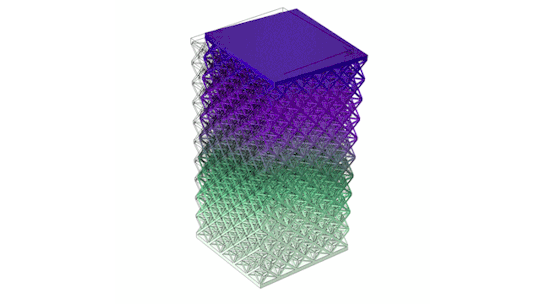
Metamaterials are products of engineering wizardry. They are made from everyday polymers, ceramics, and metals. And when constructed precisely at the microscale, in intricate architectures, these ordinary materials can take on extraordinary properties.
With the help of computer simulations, engineers can play with any combination of microstructures to see how certain materials can transform, for instance, into sound-focusing acoustic lenses or lightweight, bulletproof films.
But simulations can only take a design so far. To know for sure whether a metamaterial will stand up to expectation, physically testing them is a must. But there’s been no reliable way to push and pull on metamaterials at the microscale, and to know how they will respond, without contacting and physically damaging the structures in the process.
Now, a new laser-based technique offers a safe and fast solution that could speed up the discovery of promising metamaterials for real-world applications.
The technique, developed by MIT engineers, probes metamaterials with a system of two lasers — one to quickly zap a structure and the other to measure the ways in which it vibrates in response, much like striking a bell with a mallet and recording its reverb. In contrast to a mallet, the lasers make no physical contact. Yet they can produce vibrations throughout a metamaterial’s tiny beams and struts, as if the structure were being physically struck, stretched, or sheared.
The engineers can then use the resulting vibrations to calculate various dynamic properties of the material, such as how it would respond to impacts and how it would absorb or scatter sound. With an ultrafast laser pulse, they can excite and measure hundreds of miniature structures within minutes. The new technique offers a safe, reliable, and high-throughput way to dynamically characterize microscale metamaterials, for the first time.
“We need to find quicker ways of testing, optimizing, and tweaking these materials,” says Carlos Portela, the Brit and Alex d’Arbeloff Career Development Professor in Mechanical Engineering at MIT. “With this approach, we can accelerate the discovery of optimal materials, depending on the properties you want.”
Portela and his colleagues detail their new system, which they’ve named LIRAS (for laser-induced resonant acoustic spectroscopy) in a paper appearing today in Nature. His MIT co-authors include first author Yun Kai, Somayajulu Dhulipala, Rachel Sun, Jet Lem, and Thomas Pezeril, along with Washington DeLima at the U.S. Department of Energy’s Kansas City National Security Campus.
Keep reading.
Make sure to follow us on Tumblr!
17 notes
·
View notes
Text
Table 26.1 gives some examples of polymers formed from compounds related to ethene, along with their common names and most important uses.
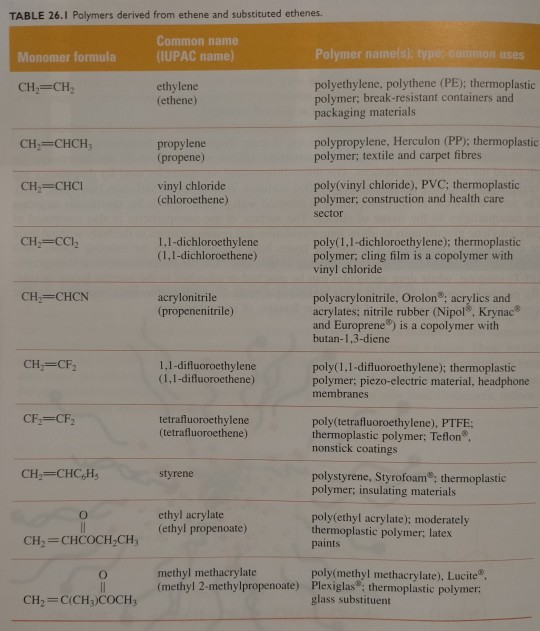
"Chemistry" 2e - Blackman, A., Bottle, S., Schmid, S., Mocerino, M., Wille, U.
#book quotes#chemistry#nonfiction#textbook#polymers#ethene#ethylene#propene#propylene#chloroethene#vinyl chloride#dichloroethene#dichloroethylene#propenenitrile#acrylonitrile#difluoroethene#difluoroethylene#tetrafluoroethene#tetrafluoroethylene#styrene#ethyl propenoate#ethyl acrylate#methyl methylpropenoate#methyl methacrylate
2 notes
·
View notes
Text
god sometimes i wish i was a polymer, life would be so much easier if i was a polymer.
i would just have to carry your groceries and be so helpful to you, or i could play music for you on a second-hand record player, i could brush your teeth for you, i could be so useful as a polymer.
trust me i wouldn’t be like one of those nasty polymers. i wouldn’t be part of the great pacific garbage patch or disintegrate into microplastics in your oceans and in your food. not me sir no i’m not like the other polymers
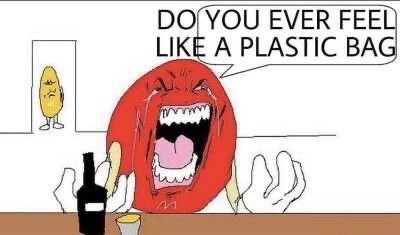
#polymers#polymer#polymer chemistry#polymer manifesto#polymer posting#chemistry#chem posting#chem#just me#shower thoughts#based#microplastics#plastic#plastics
3 notes
·
View notes
Text
World’s first ice cream made from plastic
Reuters | 28 September 2023

The world’s first food made from plastic waste - according to its developer - is vanilla ice cream.
Despite being locked in a freezer in London, she hopes it kickstarts a heated debate about the future of food and the plastic pollution crisis.
The ice cream is actually an art installation called ‘Guilty Flavours’ by artist and designer Eleanora Ortolani, 27, intended to challenge the way we think about plastic waste and what we are - and are not - prepared to eat.
"Guilty Flavours is what I believe is the first sample of ice cream made from plastic waste,” Ortolani told Reuters at Central Saint Martins, part of the University of the Arts London.
“It's coming from the same plastic as we can find in bottles, plastic bottles,” she said.
The process, developed by scientists in Edinburgh, harnesses the metabolic power of bacteria and enzymes to behave as eco-friendly factories to digest polyethylene terephthalate (PET) and turn it into vanillin, the molecule that gives vanilla its flavour.
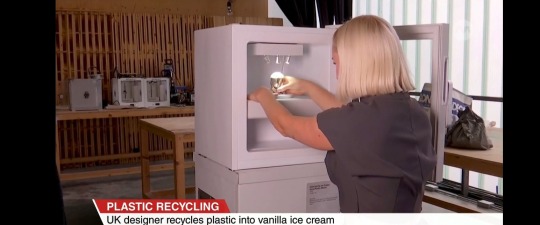
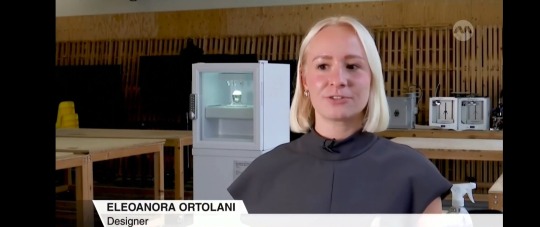
“There are certain enzymes which do certain chemical reaction,” Dr Joanna Sadler, a biotechnologist at the University of Edinburgh, told Reuters.
“So if you plug those together, you can get through to lots of different chemical products," she said.
Plastic is made of a string of molecules bonded together into what are known as polymers.
Sadler broke those bonds with a hungry microbe, leaving her with molecules that were no longer plastic.
That former PET-soup was then easily processed by another bacteria into vanillin.
Sadler's research, published in the Journal Biochemist in December 2021, focuses on degrading and upcycling plastic and using it as feedstock for microbial growth.
She produced the specially engineered bugs for Ortolani's project but was at pains to point out that the student's ice cream is very much a research project.
It's not currently for human consumption.
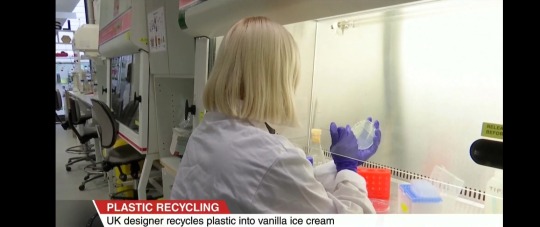
"I've even had members of the public email me saying it's irresponsible to encourage people to eat plastic," Sadler said.
"It is really important that we take the safety side of it really, really seriously and we make it very clear that this has to go through exactly the same regulatory processes and food standard processes as any other food ingredient.
And only once it has been through all of those would it go anywhere near any kind of consumer product."
Ortolani, who is from Verona, Italy, said Guilty Flavours was inspired by her frustration with the failure of the recycling system to stop plastic polluting the environment.
It is locked away to highlight what she says is a looming global food crisis.
“We have the tools today to rethink the food system we're living in,” she said.
“This is ready now and today but nobody can really touch it or interact with it because it's not tested for safety yet."
Vanilla, sometimes called 'green gold', is the second most expensive spice in the world after saffron.
youtube
UK designer recycles plastic into vanilla ice cream
27 September 2023
Introducing the world's first food made from plastic waste... vanilla ice cream!
Named Guilty Flavours, the ice cream has been designed to provoke viewers into thinking about plastic waste.
The ice cream was developed by scientists in Edinburgh, who used bacteria and enzymes to digest PET plastic and turn it into vanillin -- the molecule that gives vanilla its flavour.
The ice cream is still in its research phase and currently not for human consumption.
#Guilty Flavours#vanillin#vanilla ice cream#ice cream#plastic waste#PET plastic#plastic pollution crisis#Youtube#Eleanora Ortolani#Central Saint Martins#University of the Arts London#polyethylene terephthalate (PET)#Dr Joanna Sadler#University of Edinburgh#plastic#polymers#Journal Biochemist#vanilla#green gold#biotechnology#recycle#upcycle
4 notes
·
View notes
Text
Super Absorbent Polymer Polyacrylate based | Chemtex Speciality Limited
Sodium Polyacrylate is a widely accepted super absorbent polymer, that finds extensive usage in various applications like ice gel packs, protective garments, baby diapers, etc., owing to its high water absorption capacity of about 300 – 400 times of its own weight.
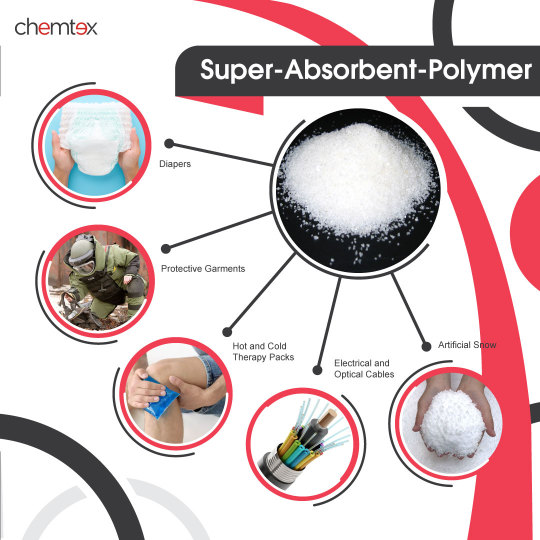
Visit-
https://www.chemtexltd.com/products-and-solutions/performance-chemicals/general-chemicals/sodium-polyacrylate/
#polymers#polymer#polyacrylamide#absorbent#watergel#chemistry#polymerclay#manufacturing#chemicals#superabsorbentpolymer#waterabsorbent#sap#chemtexspecialitylimited
2 notes
·
View notes
Text
Cyanoacrylate
Monomer that undergoes polymerisation to form the adhesive
Super glue
2 notes
·
View notes
Text
This one goes out to a post I found in which the OP made a Seinfeld skit where Jerry wished someone would make waffle makers out of polymers cuz he wanted to see how the waffles cook. 🧇
raise a glass to the posts you love that end up deleted. to the fanart and fanfics you lose track of and can't locate. to the blogs you used to look through that ended up unexpectedly disappearing. to the things you didn't archive because you always assumed they'd be there.
109K notes
·
View notes
Text
A team of materials scientists and engineers at ETH Zurich has developed a light-triggered chemical process for breaking down certain polymers into their constituent monomers. The paper is published in the journal Science. In recent years, scientists have become aware of new problems associated with the mass production of polymers—microplastics can now be found on every part of the Earth, including inside virtually every person on the planet. Part of the problem is the difficulty and expense involved in recycling plastics, which makes it easier to throw them in the trash or the ocean.
Continue Reading.
83 notes
·
View notes
Text

New plant-based glitter shows no harm to soil organisms
Plastic pollution is everywhere. Each year, over 368 million metric tons of plastics are produced with over 13 million metric tons of it ending up in the soil where it can be toxic to wildlife. Researchers are particularly worried about the environmental impacts of 'microplastics' which are small plastic particles less than 5 mm in size. Microplastics can be produced from products like glitter or when larger objects, including water bottles, break down into smaller and smaller pieces once they're in the environment. Due to their small size, animals can eat microplastics, mistaking them for food, which can cause starvation and malnutrition as well as abrasions to the gastrointestinal tract.
Read more.
#Materials Science#Science#Polymers#Plastics#Pollutants#Glitter#Waste#Environment#Biomaterials#Plants#Cellulose#University of Melbourne
63 notes
·
View notes
Text
Additive manufacturing, also known as 3-D printing, is a transformative approach to industrial production that is making lighter, stronger parts and systems a possibility.
This article will delve in the concept of additive manufacturing, its types, and the materials used in additive manufacturing.
What is the additive manufacturing?
Additive manufacturing is processes used to create a three-dimensional object by laying down successive layers of material under the control of a computer. Objects created can be of almost any shape or geometry and are created from digital model data. It is intended to construct a part from scratch but raw material, using digital data coming from a CAD file.
The familiar term of additive manufacturing is 3D printing. This is a popular type of additive manufacturing.
#science#materials science#engineering#materials science and engineering#materials#metals#polymers#composites#ceramics#biomaterials#3D printing#additivemanufacturing
2 notes
·
View notes
Text
Putting this here in TikTok form to see if it does any better but here’s me making one of the “Tri Angels” from the Book of Bill!
Edit: since some people have asked, I used FIMO professional oven bake clay to create this! :)

#art#my art#gravity falls bill#gravity falls bill cipher#gravity falls#gravity falls fanart#book of bill#the book of bill#bill cipher#bill ci the triangle guy#clay figurine#clay art#polymer clay
33K notes
·
View notes